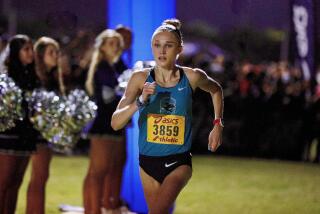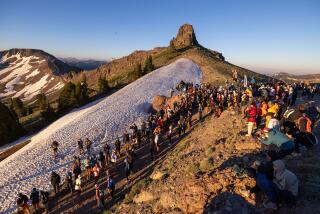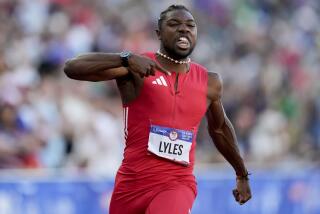The Distant Wall : Prep Milers Get Farther Away From 4 Minutes
Jim Ryun might have been America’s greatest mile runner, but not even he could have guessed that his high school record would go unchallenged for 25 years.
Ryun, already an Olympic veteran and three-time Kansas prep champion, was 18 and a graduate of Wichita East High when he set the record of 3 minutes 55.3 seconds on June 27, 1965, at the national AAU meet in San Diego.
A month earlier, he had set the national high school federation record of 3:58.3 at the Kansas state meet. And a year before that, Ryun had become the first high school athlete to break the four-minute mile when he clocked 3:59.0 in finishing last at the Compton Invitational.
“The night Jim broke the four-minute mile, he wrote in his log book that he ran a 3:59.0 and didn’t put anything special by it,” said Bob Timmons, Ryun’s coach in high school and at the University of Kansas. “I don’t think he had any idea what he had just accomplished. He was 17 and a phenom, but he was still just a tall, quiet and unassuming kid.”
Only two other prep runners have broken the four-minute mile, and neither came close to Ryun’s record. Tim Danielson of Chula Vista, Calif., ran a 3:59.4 as a senior at the national AAU meet in San Diego in 1966. Marty Liquori was a senior at Essex Catholic High in Newark, N.J., when he ran a 3:59.8 in 1967.
Since then, only Richard Kimball of De La Salle High in Concord, Calif., has seriously challenged the four-minute mark when he ran a 4:02.4 in 1974. The fastest mile in the last decade was a 4:03.59 by John Quade of Woodinville (Wash.) High in 1985.
Today’s prep milers seem to be getting slower. The top time this season was 4:08.52 by Darrell Hughes of Galloway Westland in Ohio.
“There are a lot of reasons as to why no one is breaking that record, but I think the main one is that American society today does everything the easy way,” said Joe Newton, a veteran coach at York High in Elmhurst, Ill., and a coach on the 1988 Olympic track team.
“Today, if a kid goes out for track and he is not an immediate success, he goes out for volleyball or water polo or something else in which he’ll do well. Most of my best distance runners toughed it out for years before they saw some significant improvement. Most kids today don’t want to work that hard.”
Still, experts are puzzled that three runners were able to run a sub-four-minute mile within a two-year span, and that no one has come close since. The mile mark remains the most elusive in track and field.
One explanation may be that runners now are not as specialized. Many double up at meets, running a half-mile and mile or two-mile. Some also run on relays.
When Ryun was in high school, state federation rules limited him to one distance race a meet. Although he occasionally ran the half-mile, he almost exclusively competed in the mile. Timmons said that gave Ryun the mental and physical capacities needed to break the record.
Ryun did not start running until high school, but once he took up the sport it became a year-round commitment. He ran on the cross-country team to condition himself for track. As a sophomore, he ran a 4:21 mile, prompting Timmons to begin talking about breaking the four-minute barrier.
“I remember driving back on the bus from a meet in Kansas City my sophomore year and Coach Timmons calling me up to the front,” Ryun said. “He said he thought I had the ability to break a four-minute mile, and he wanted to help me visualize that goal. I was just a kid and I was tired that day, so trimming 21 seconds off of my time seemed like an impossible dream. I couldn’t visualize it at the time.”
By the end of his junior year, Ryun believed he could. He was invited to the Compton Invitational in June of 1964 to compete against the best milers in the country. Although University of Oregon graduate Dyrol Burleson won in 3:57.4, Ryun’s eighth-place finish in 3:59.0 had the crowd talking.
“There was nothing unusual about the win,” Burleson told The Times after the meet. “The whole story of the race was back there in eighth place, where that high school kid did 3:59. I wonder what this kid will be doing by the time he grows up? Or even what he’ll do before this year’s over, the way he’s improving.”
Ryun did it again and again and qualified for the 1964 Olympics in Tokyo. Although he failed to make the finals in the 1,500 meters, Ryun said he was happy just to make the team.
He ran in the next two Olympics, winning the silver medal in the ’68 Games at Mexico City. He fell in a heat in the ’72 Munich Games.
Ryun believes that his outstanding mile was his 3:58.3 at the state high school meet his senior year. Although he broke four minutes five times in high school, that race was the only one exclusively against prep competition.
“You have to be an unusual individual to break a four-minute mile,” Ryun said. “A lot of things have to work your way, and you have to have a coach that knows how to develop you. It certainly makes me feel unusual, though, that the record hasn’t been broken. I think Tim and Marty would agree with me that none of us thought the four-minute mile would be a dead-end street after 1967.”
Liquori, a track commentator for several television networks, ran a 4:13 mile his junior year at Essex Catholic and managed to trim nearly 14 seconds off that time as a senior at the national AAU meet in Bakersfield. He went on to star at Villanova University, where he won five NCAA titles.
He never made the Olympic team. A foot injury kept him out of the ’72 Games, and he pulled a hamstring in the ’76 Olympic trials while running the 5,000 meters.
“Running against tougher competition was a definite advantage for me,” Liquori said. “Kids today are not getting those opportunities.”
Danielson enjoyed little fame after breaking four minutes on June 11, 1966. He went to Brigham Young University but transferred to San Diego State after only a year. And he never broke the four-minute mile again.
A week before running his 3:59.4, Danielson won the state finals in Berkeley in 4:07.0. He had run a personal-best 4:06.2 the week before that at the CIF San Diego Section meet.
“We got him in the national AAU meet because we thought he had a shot at breaking four minutes,” said Harry Taylor, Danielson’s high school coach. “He really came through that day.
“Tim was the best distance runner I ever coached. He always worked so hard and never complained. On the weekends, he would go up to the mountains where he was a camp counselor and train. When he was at home, he would sprint between telephone poles in the neighborhood. He was always striving and working to be better.”
Taylor and Timmons agree that today’s distance runners do not want to work as hard.
“Getting under four minutes takes a lot of hard work,” said Taylor, who retired from coaching in 1981. “You also have to have the competition. There aren’t as many good distance runners these days, so it’s hard to push when there’s no one behind you.”
Newton blames the LSD (long, slow distance) running philosophy for the lack of a threat to Ryun’s record. In recent years, many articles have said it is better for athletes to ease into running by going long and slow and making it enjoyable.
“Kids and coaches read that stuff and they believe it,” Newton said. “A high school coach’s job is to get the most out of a kid when he’s with you. I can’t worry about what he will do in college and beyond that. Most don’t make it in college, so it is better to get the most out of them while they’re in high school.”
America’s top-rated miler, Joe Falcon, said that he believes it is important not to burn out a runner in high school.
“To break the four-minute mile in high school, a runner has to do an awful lot of training,” said Falcon, who attended the University of Arkansas. “To a high school athlete, it is a disadvantage to train that hard at that age. By the time they get to college, they will be burned out and suffer from fatigue.”
Falcon, 24, ran a 4:08.1 as a senior at Belton (Mo.) High. His best time in college was a 3:52 at a meet in Zurich, Switzerland. His personal best is a 3:49.31.
“Every year I’ve improved,” he said. “I’m getting stronger and stronger.”
Earlier this year, there was hope for Louie Quintana of Arroyo Grande High. As a junior, he had run a 4:07 in winning the Southern Section 2-A Division championship. After winning the state cross-country title last November, Quintana and his coach, Greg DeNike, thought four minutes was a realistic goal.
Before the season, Quintana said: “Now that the goal has really emerged, I feel that I have a shot to do it. But it’s going to take a lot of work.”
But Quintana, 18, suffered a knee injury in March. He ran the half-mile for part of the season, and finished a disappointing fourth in the mile at the state meet earlier this month in 4:14.43.
“Breaking a four-minute mile just was no longer a priority for me,” said Quintana, who will attend Villanova in the fall. “It is hard to explain, but it is a very difficult thing to do. So many factors have to be working your way, that it is almost an impossible task. Believe me, I found that out this year.
“Everyone kept asking me when I was going to break four minutes,” he said. “It got to the point where winning wasn’t as important as the record. I got tired of people asking me, and I almost lost focus of what I was out there trying to do. Winning is always the most important thing.”
The Sub-Four Club
No high school runner has broken the four-minute mark in the mile since Marty Liquori in 1967. A look at the runners who did:
Runner School Year Time Jim Ryun East, Wichita, Kan. 1965 3:55.3 Jim Ryun East, Wichita, Kan. 1965 3:56.8 Jim Ryun East, Wichita, Kan. 1965 3:58.1 Jim Ryun East, Wichita, Kan. 1965 3:58.3 Jim Ryun East, Wichita, Kan. 1964 3:59.0 Tim Danielson Chula Vista 1966 3:59.4 Marty Liquori Essex Catholic, Roselle, N.J. 1967 3:59.8
More to Read
Go beyond the scoreboard
Get the latest on L.A.'s teams in the daily Sports Report newsletter.
You may occasionally receive promotional content from the Los Angeles Times.










